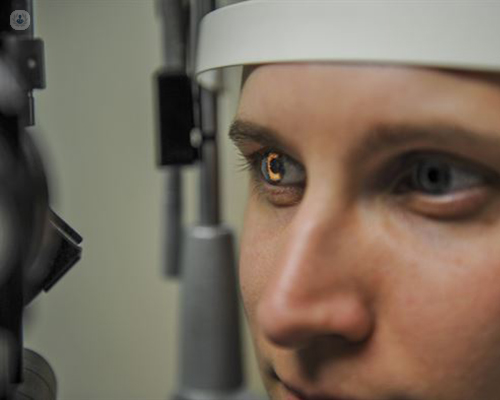Astigmatism
Mr Imran Jawaid - Ophthalmology
Created on: 07-23-2013
Updated on: 06-06-2023
Edited by: Jay Staniland
What is astigmatism?
Astigmatism is a condition where the shape of your eye is more like a rugby ball than a football, causing blurriness in vision. People with astigmatism are generally born with it, but sometimes the condition can develop as a result of surgery, injury, or an illness. Astigmatism is usually accompanied with long-sightedness or short-sightedness.
What are the causes of astigmatism?
Astigmatism occurs when the curvature of the surfaces on your eye are irregular, resulting in a refractive error.
Your eye has two curved surfaces – the cornea and the lens – which bend, or refract, light. In a perfectly functioning eye, both the cornea and lens have two curves that match each other, resulting in a sharp image. However, if the curves are mismatched in either the cornea or lens, your retina will receive a blurry image. A fault in the cornea is called corneal astigmatism while a fault in the lens is called lenticular astigmatism.
Both of these types come under the bracket of regular astigmatism, which is by far the most common form of astigmatism. Irregular astigmatism involves a cornea or lens which is curved in multiple directions, curved asymmetrically, or uneven in other ways. It is much more difficult to correct and not usually possible to correct with glasses. However, irregular astigmatism occurs much more rarely than the regular form, and is usually the result of an injury to the eye or illness. The rest of this article focuses on regular astigmatism.
What symptoms are likely to indicate astigmatism?
The main symptom of astigmatism is blurry vision, which can come with:
- headache
- eye strain (especially from reading or looking at a computer for a long period of time)
- squinting
How is astigmatism diagnosed?
Astigmatism, along with long and short-sightedness, can be diagnosed by an optometrist during a comprehensive eye exam. The doctor will be able to determine from this what degree of astigmatism you have, and therefore what your corrective options are.
What are the different treatment options for astigmatism?
Astigmatism can usually be corrected with glasses or contact lenses. Both involve the use of artificial lenses to give you clear vision. From your eye exam the optician will produce a prescription, which states what kind of lens you need.
Previously, it was not possible to buy soft contact lenses for astigmatism, and the only option was the use of rigid lenses. Now, however, a special form of soft lens called 'toric' lenses are available.
For stronger forms of astigmatism, the cost of contact lenses can increase, and the range of frames you can wear may be restricted. If you opt for eyeglasses or contact lenses, it is important to have your eyes regularly tested because the shape of your eyes change gradually over time, and your prescription might change.
Finally, laser eye surgery is often an option, but can be more expensive and may carry the risk of complication.

How common is the condition?
Astigmatism is very common. Roughly 50 per cent of people in the UK who wear glasses have some form of astigmatism.
What are the main associated risk factors?
It has been shown that individuals who have a family history of astigmatism are at a higher risk of suffering from the vision-affecting condition. People who smoke, particularly during pregnancy, can increase their babies chances of contracting astigmatism in later life. Also, it has been demonstrated that people of Hispanic and African American descent are more susceptible to contract the eye disorder.
Is 20/20 vision possible with astigmatism?
Yes, indeed it is. Patients with a mild degree of astigmatism can certainly experience 20/20 vision, whilst it is also possible for patients who have been diagnosed with a more severe or noticeable case of astigmatism to experience 20/20 vision with the use of glasses.
Can astigmatism go away on its own?
Astigmatism will, in most cases, remain the same from the age of 25 onwards. Astigmatism can "disappear" in young children (under the age of six), but will remain in all patients above the age of six without adequate and effective correction and treatment.
Can astigmatism cause lazy eye?
Yes, astigmatism, especially if left untreated, can lead to a condition known as amblyopia (also known as lazy eye).
When can children undergo surgery to correct astigmatism?
It is not recommended to have LASIK or another refractive surgical procedure before one's eyes have stopped growing, which is typically around the age of 18.
Are glasses always necessary for patients with astigmatism?
No, not necessarily. In cases where patients only experience a mild form of astigmatism, glasses are not required.
Does astigmatism occur in one eye or both eyes?
Interestingly, some patients will only suffer from blurred vision in one eye, with their other eye maintaining clear vision.
















